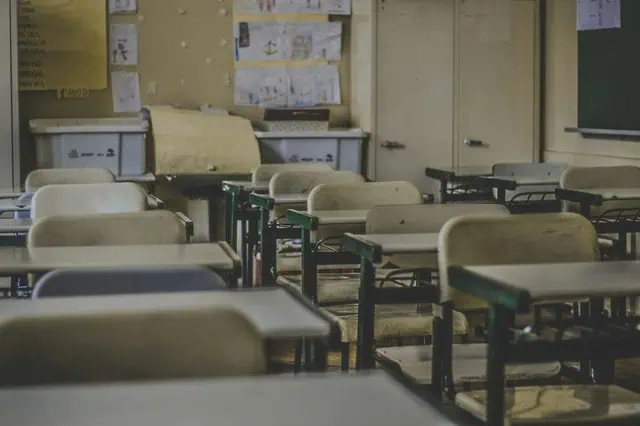
When the pandemic hit in early 2020, classrooms sat vacant as students moved to virtual instruction. Four years later, schools have moved back to in-person instruction, but some classrooms have remained emptier than usual. Chronic absenteeism rates have spiked since the pandemic, according to Colorado Department of Education (CDE) data. About 1 in 3 students in the state are missing more than 10% or more of a school year, about 18 days a year, according to data from the 2022-23 school year.
Numbers are trending in the right direction — at its peak in the 2020-21 school year, 36% of students were chronically absent, compared with 31% in the 2022-23 school year (data for the 2023-24 is expected to be released in the fall). But for the four years pre-pandemic, chronic absenteeism stayed between 18% and 24% statewide.
“We’re seeing progress for kids reengaging and reconnecting to schools, but we’re still seeing pretty high levels,” said Johann Liljengren, director of dropout prevention and student engagement for CDE. “That has a huge impact on schools, districts and classrooms.”
Rates are a bit better and also on the decline in Boulder County schools — just over 1 in 5 students in Boulder Valley School District (BVSD) and 1 in 4 in St. Vrain Valley School District (SVVSD) were chronically absent in the 2022-23 school year. But that is still considered high by nonprofit initiative Attendance Works, a level of absenteeism that the organization says not only impacts the students missing school, but also their peers.
“Even that student who has 100% attendance or 95% attendance, when their classmates are gone every other day, it impacts the type of learning they get to experience” as teachers navigate getting students caught up, Liljengren said.
As the state and districts work to boost attendance, strategies range from hiring new staff to making home visits at students’ homes. But time will tell what it takes to return attendance to pre-pandemic levels.
“We’re being as supportive as we can and helping students no matter what the situation,” said Elton Davis, a director of student support services at BVSD. “We want to make sure that students are having their access to education.”
‘Missing school matters’
Chronic absenteeism data differs from truancy data in that it doesn’t distinguish between excused and unexcused absences. While schools used to focus their efforts on truancy (unexcused absences), Liljengren says the focus has shifted to chronic absenteeism in the last decade or so.
“Whether it’s unexcused or excused might help with their response to it,” Liljengren said, “but missing school matters whether it’s unexcused or excused.”
Liljengren said kids in kindergarten with high attendance are more likely to read on grade level by third grade. In middle and high school, kids with low attendance are more likely to struggle in their courses and drop out of high school later on. “Almost all” ninth graders with high attendance graduate later on, he says.
“There’s really strong connections that it matters for individual kids.”

A multi-pronged issue
Liljengren attributes the rise in chronic absenteeism to several factors.
One is around health and wellness broadly. “We moved to a very cautious approach on sickness” after the pandemic, he said, causing kids to stay home when they may have come to school in the past.
And like so many other sectors, schools have also faced a shift in norms and expectations around being in-person.
“Families have kind of recognized through COVID that you can still access materials and things like that to do assignments for classes,” Davis said. They “sometimes equate doing assignments as actually being in class and receiving instruction, which is not equivalent.”
Liljengren said that while schools were able to create “some awesome tools” for kids to access information in different spaces, they’re trying to “reset” on live and engaged learning, whether that’s in-person or virtual.
On top of that, Liljengren said mental health and feelings of safety in school might also contribute to poor attendance. While a recent statewide survey showed improvements in mental health for high schoolers, parents’ and students’ fears for their safety at school have risen sharply since 2019, according to a 2022 Gallup poll. The poll didn’t specifically reference gun violence, but Gallup noted that parents’ fear spikes after high-profile mass shootings.
Another contributing factor is increases in staff turnover and lingering vacancies, something Liljengren said “impacts relationships kids build and consistency of [those] relationships.” For the 2023-24 school year, the state saw a 20% turnover rate for staff including teachers, support staff and administrators. BVSD saw a slightly lower turnover rate at about 17% and SVVSD a bit lower at about 15%.
That’s slightly worse in Boulder County than pre-pandemic, when turnover rates were about 16% for SVVSD and 14% for BVSD, according to fall 2019 CDE data. Statewide turnover rates were about the same pre- and post-pandemic.
Things like transportation difficulties and family responsibilities might also keep kids, especially high schoolers, away from the classroom.
Sometimes, chronic absenteeism can be a snowball effect as support systems and staff become overtaxed.
“Increasing numbers just make the work more challenging. We saw some districts that doubled the number of kids chronically absent,” Liljengren said. “If you have a counselor doing intensive follow up and now you feel like you need twice as many counselors… districts have really taken a couple of years to kind of reorganize, and how do you get more staff involved?”

A holistic approach
As schools, districts and the state worked to address chronic absenteeism in the wake of the pandemic, CDE put together a cohort of about 20 districts in the 2023-24 school year to try to collaboratively address absenteeism. That cohort is continuing in the upcoming school year.
St. Vrain Valley School District did not join the cohort and did not respond to repeated requests for comment to multiple communications officials over several weeks.
BVSD’s Davis said the learning group was a good chance for districts to “put [their] heads together.”
At BVSD, addressing absenteeism starts before it becomes chronic by communicating with families as soon as possible and setting up a plan within the classroom, Davis said. If a student continues to miss school, administrators are put on notice, and attendance and engagement specialists work with students and families to identify root causes and put together a supportive intervention plan.
Notably, those plans look different depending on students’ age and the challenges they face.
Kindergarteners, for example, had the third highest levels of chronic absenteeism statewide in the 2022-23 school year after juniors and seniors in high school. That’s unusual, Liljengren said, and efforts for younger kids might focus on “a different, intensive partnership you’re building with families.”
There are also socioeconomic gaps when it comes to attendance. Students experiencing homelessness, for example, are chronically absent at nearly double the rate of the general student population.
Davis said that in recent years, efforts at the school and district level have taken a more proactive, holistic approach.
“We really need to know the reasons why, what are the barriers for students and what are the struggles that students and families are having,” he said. “We just have to look at things really differently and how we’re supporting the student and the family as a whole.”
If a student has transportation issues, for example, the school might help coordinate rides with other families that live close by. If a student is struggling with anxiety, Davis said they might look at options for accessing curriculum remotely and, depending on the severity, could look at remote school through Boulder Universal or the district’s Advanced Alternative Learning Program for Students (AALPS).
AALPS began in 2019 and is a half-day program that prioritizes low teacher-to-student ratios and “carefully designed wrap-around services that are incorporated into the program in order to meet each student’s individual needs and goals,” according to its webpage.
State and county grants that have funded programs like AALPS “have played massive roles” in improving attendance numbers, Davis said.
Some districts have also used COVID relief funds to hire engagement staff members or additional school health professionals and counselors, who “have an enormous impact on school attendance,” Liljengren said.
Heading into next school year, CDE is working to target more funding opportunities for individual districts and schools and is continuing to facilitate discussions on best practices through the learning cohort, Liljengren said.
BVSD is updating its internal data systems to allow the district to get more in-depth information and has revised and streamlined its attendance policy, which Davis said will make a “significant difference” in understanding and expectations around attendance.
And in the coming years, the state and district will be closely watching the story the data tells.
“We’re not in any position where we would be satisfied,” with a particular level of absenteeism Davis said. “We want to make sure that we are always improving.”
